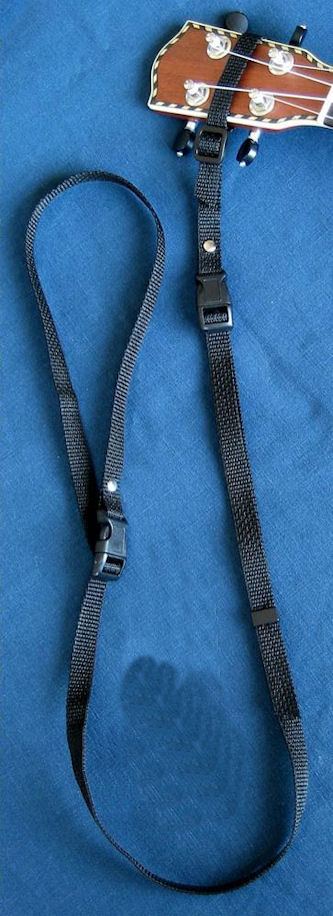
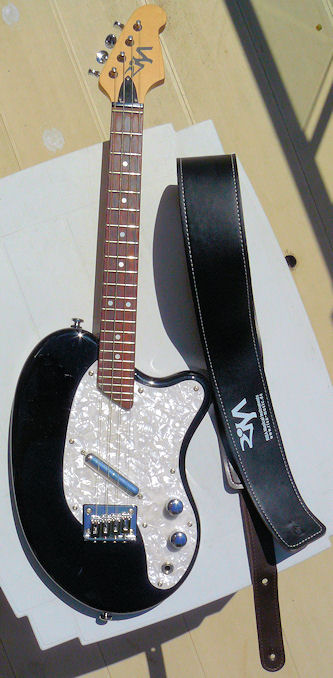

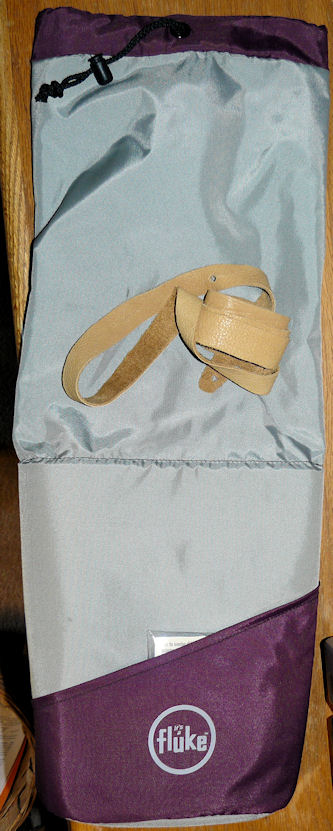
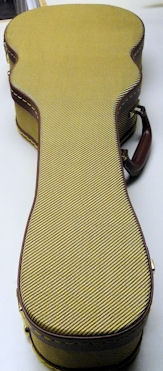

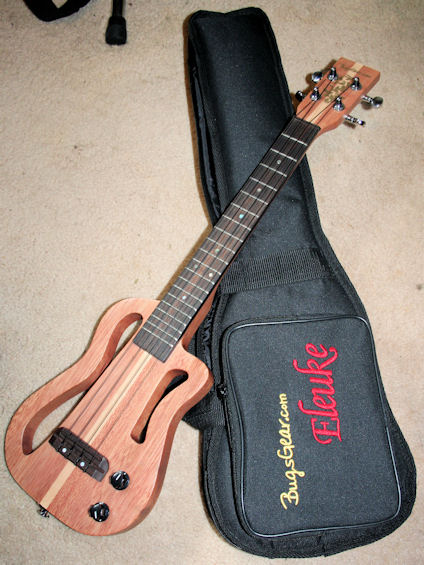

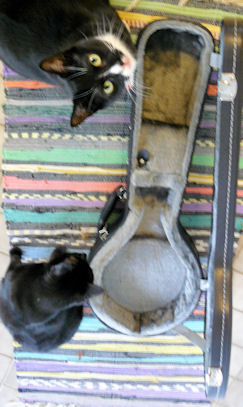
Straps
Ukuleles are small and easy to hold, and that means they're also easy to drop. Do you absolutely need a strap to hang onto one? No, but they do give you more mobility and security. Women often wrestle with holding ukes too, because they may not be comfortable pressing the instrument against their breasts and bras.
The business of playing music means your hands and arms are always in motion. Me, I like straps because they allow my arms and hands more freedom.
Straps also provide another service: they allow for more sound from the back and sides of the ukulele.
Try a simple experiment: play your ukulele on your lap, held away from your body. Then hold it close, pressing the back against your chest. You should hear the difference - so should listeners around you.
Without a strap, most players press the uke tightly against their body. This dampens the vibrations that the back produces, both as a secondary sound board and as a reflector. The top board - the most important sound producer - is constrained by your forearm when you're holding the uke against your body. Straps help prevent that.
 A
new design - the Uke Leash
- might prove the best and most ingenious solution yet. This was developed by Lori
Apthorp, a UU forum member
who struggled with the same problems holding a uke we all have and came up with
a new idea. It's simple and effective!
A
new design - the Uke Leash
- might prove the best and most ingenious solution yet. This was developed by Lori
Apthorp, a UU forum member
who struggled with the same problems holding a uke we all have and came up with
a new idea. It's simple and effective!
It is based on the quick-release clips you often see on pet collars and leashes. Comes in many colours and three sizes. The top piece is separate from the leash, so you can attach a head strap to every uke you own and simply click it to the leash part. Unlike the uke thong (below), it doesn't clip to the soundboard, so it won't affect the sound.
The leash portion can be worn around your arm, shoulder, clipped to a belt loop or even strapped to a thigh. I found the shoulder-armpit position the most comfortable, but the belt-loop connection could work as well.
Lori sent me two versions - one of leather the other polypro. Both are nicely made and work equally well. The leather looks nicer (to an aging biker like me), but there's really no difference in how they perform.
The Uke Leash has two advantages over standard straps. First the two-part system lets you quickly change ukes during play or performance if you have head strap on each one. Just leave the shoulder leash on and unclip the head strap.
Second, with your right arm not having to press the uke so tightly, sound is noticeably improved. And like a standard over-the-shoulder strap, your left hand is much freer to move, make chords or do fancy fingering. This also means less abrasion on the back of the uke from clothing, buttons, etc.
Another point to note: if you drop your uke with the leash attached, the Uke Leash keeps it from falling and hitting the ground. This isn't true of the uke thong, shown below. And the Uke Leash is small and fits more easily into a uke case than a standard guitar strap.
The Uke Leash is my favourite type of strap.
An alternative strap is the uke' thong' - a simple padded hook that goes into the sound hole, and a loop/strap that goes around your neck. There are guitar versions of this idea, too, but the uke version is smaller. Plus there are some alternate designs with less cloth. This is not the underwear sort of thong: do not attempt to wear it to the beach!
The thong has the advantage of being light and simple. However (and there's always a however...) the hook creates a fulcrum point. Your uke can tilt to either side and fall down, or fall forward if you let it go. Dropping a musical instrument is never a good idea.
The thong doesn't hold the uke up as much as it gives you a little more freedom of motion, especially your right strumming/picking hand, because your arm doesn't need to hold the uke as tightly. And of course that means fewer fingerprints or arm prints on the surface to clean later.
The downside is that the hook is held on at the soundboard. To get the fullest and loudest sound, the soundboard must not be restricted, and using the thong dampens the sound - noticeably so. So it's a good for practice, but may work against you in performance.
The version I have is modestly adjustable, by knotting the piece that goes over the neck. I would prefer a clip or sliding snap of some sort that let me adjust it more easily.
I have one: I am not enthused with it, but I sometimes use it when I am playing around the house, just to give me a little more freedom of movement (and allow me to pick up a wine glass without putting the uke down). It isn't as good for Flukes either, because of the angled plastic shell, but it's still usable with them. I worry that the friction on the sound hole and top may, over the long term, abrade and damage the finish.
The traditional guitar strap is usually around 2" wide wide, and feels like using a Hummer just to drive to the corner store, a block away. It's big and hefty, designed for something much larger and heavier. And it doesn't always fit into a uke case very well (unless you get a thinner, fabric one).
I found a somewhat smaller strap made from a 3/4" wide strip of leather with a 10" long, 2" wide padded shoulder strap. It's a lot more practical for a uke than a 2" wide strap, but still big. I use a guitar strap on my Gold Tone banjolele, however, because the BU is heavy and needs the support.
The real advantage of the traditional strap is that it frees both hands for playing. And that means a lot less pressure on the top, so the music can sound more full.
Ideally, a thin strap that tied to the head under the strings and to a pickup jack or strap knob would work the best, although something that went under the body to cradle it might also work (it would be a bit precarious). I'm told that mandolin straps are workable for ukuleles, too. It should be fairly easy to get some decorative cord or leather to make one of your own.
A friend gave me a large piece of deer hide that I cut into lightweight, homemade straps, and used office-supply round head fasteners to hold the ends closed, but it's a bit plain and looks like a six-year-old made it. They work, but elegant they aren't.
Since the uke is light and small, a shoulder pad is really unnecessary. Traditional guitar straps work well on the Eleuke, Risa, U-bass and Applause since these ukes come with two strap buttons (and they're relatively heavy). However, many ukes have one or even no buttons. So you need to have something different at the head (a shoelace tied around the head, under the strings works).
It's pretty easy to rig up a cord or leather strap that hangs off the pickup jack, but what if your uke doesn't have a jack or a strap knob? I don't recommend anyone but an experienced luthier drill a hole to install a knob. There are some simple screw-in end pins you can get from most music stores, but again you need to be confident in installing them - preferably into an end block, not merely into the unsupported wood.
Cases and gig bags
Ukuleles need protection when you travel, or when you're at home and not playing them. That's what cases and gig bags are for. They're also used to carry your basic kit to and from gigs.
The difference between the two is simple: cases are hard and provide more protection. In theory, a good case can protect your uke from harm even in transit on an airplane, in the luggage hold , on the carousel, or in a box in the mail or shipped by courier.
Hardshell cases offer the best protection but have less space for accessories. Apparently no hardshell manufacturer is also a musician, because none of them I've seen have the pockets or storage areas that musicians NEED! The better option is the bulkier Styrofoam case that has external pockets, but it may be more susceptible to damage.
Some hardshell cases are available in tweed (see photo, left). It's great-looking but it wears faster than the smoother materials. There are also some plastic cases appearing that have smooth, tough exteriors like modern airline luggage.
Gig bags are soft and provide minimal protection from banging, thumping, and scraping. They are okay for storage or local travel and will keep the rain off your instrument. They are okay for carry-on luggage, but are not safe in the cargo hold of a plane. If you travel with a gig bag, consider wrapping the uke in bubble-wrap to give it an extra layer of protection.
Cases and gig bags should be lined with some non-abrasive material to prevent scuffing and abrading the finish. Your typical backpack doesn't have this and the nylon will mar the surface if you carry an unprotected uke in it for very long (learn from my mistakes!).
Fit should be snug and not give a lot of movement room inside, but still be comfortable enough that the gears don't get moved every time you move the uke in or out of the case. I get annoyed when I have to tune my uke every time I take it from its case or bag.
Both cases and gig bags should provide some sort of pocket or holder for spare strings, picks, tuner and so on. Most gig bags and some cases have outside pockets that can carry chord and song books, cables, and other impedimenta. I personally prefer a case with pockets because it means I don't need to carry some other item to hold the rest of the gear I figure I need.
Ideally, an external pocket should be large enough to hold an inch-thick song book - today usually US letter size (8.5 x 11"). External pockets should be sealable - zipper or Velcro - not open so things can fall out. If you don't have one - look in a store like Canadian Tire or Walmart for small mesh bags (sometimes in the luggage section), especially something with velcro.
Inside cases there should be a closable space to hold extra strings, picks, truss rod, harmonica and a digital tuner. The case should also accommodate a humidifier (usually kept under the head) but don't let this rattle around when transporting it (put it in the inside space for travel). I've always found guitar straps problematic and generally a little too bulky to fit comfortably in many uke cases (except for some of the thinner fabric straps). The Uke Leash is small enough to fit, so is the Uke Thong, but guitar straps are a lot bigger.
The lack of adequate pocket space in and on most cases and gig bags leads me to believe most manufacturers and designers aren't musicians. Either that or they have a tidy sideline selling accessory bags. Either way, I have yet to find a case with more than minimal storage space.
Many online sellers offer package deals with a uke and a case (plus sometimes books, DVDs, tuners or extra strings) for a price that's lower than the individual elements combined.
